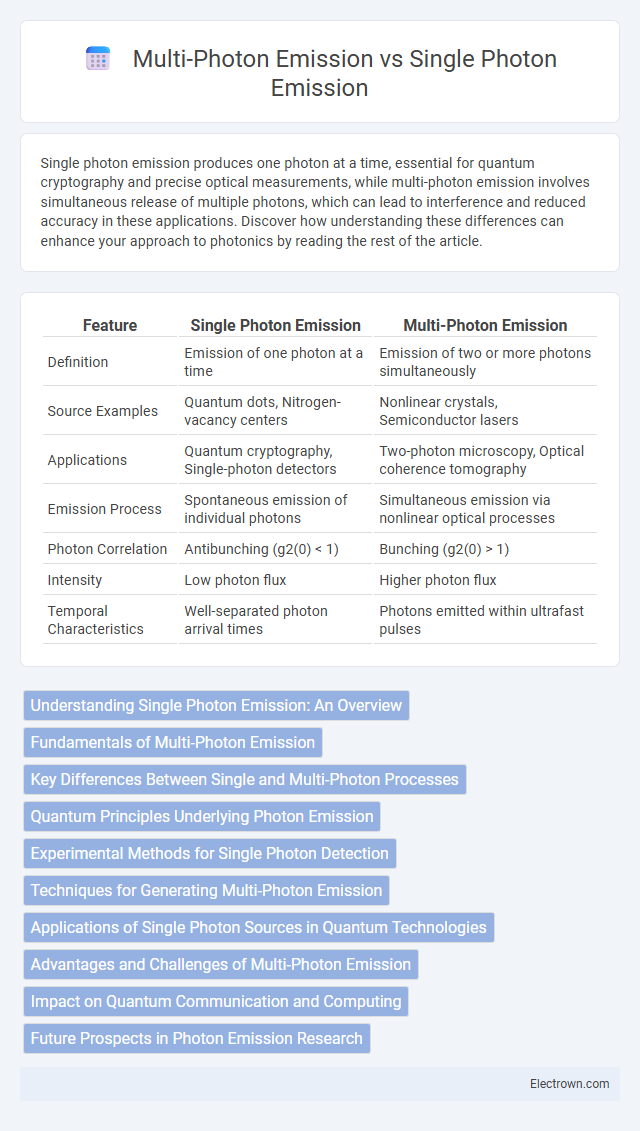Single photon emission produces one photon at a time, essential for quantum cryptography and precise optical measurements, while multi-photon emission involves simultaneous release of multiple photons, which can lead to interference and reduced accuracy in these applications. Discover how understanding these differences can enhance your approach to photonics by reading the rest of the article.
Table of Comparison
| Feature | Single Photon Emission | Multi-Photon Emission |
|---|---|---|
| Definition | Emission of one photon at a time | Emission of two or more photons simultaneously |
| Source Examples | Quantum dots, Nitrogen-vacancy centers | Nonlinear crystals, Semiconductor lasers |
| Applications | Quantum cryptography, Single-photon detectors | Two-photon microscopy, Optical coherence tomography |
| Emission Process | Spontaneous emission of individual photons | Simultaneous emission via nonlinear optical processes |
| Photon Correlation | Antibunching (g2(0) < 1) | Bunching (g2(0) > 1) |
| Intensity | Low photon flux | Higher photon flux |
| Temporal Characteristics | Well-separated photon arrival times | Photons emitted within ultrafast pulses |
Understanding Single Photon Emission: An Overview
Single photon emission involves the release of one photon at a time, a property essential for quantum cryptography and advanced photonic technologies. This phenomenon contrasts with multi-photon emission, where multiple photons are emitted simultaneously, often leading to signal interference and reduced precision in applications requiring quantum-level control. Understanding the mechanisms behind single photon emitters, such as quantum dots and nitrogen-vacancy centers in diamonds, is crucial for developing secure communication and high-resolution imaging systems.
Fundamentals of Multi-Photon Emission
Multi-photon emission occurs when an excited atom or molecule simultaneously emits two or more photons upon returning to a lower energy state, a process governed by higher-order quantum transitions and nonlinear interaction with electromagnetic fields. This phenomenon contrasts with single photon emission, where only one photon is emitted during the energy relaxation process, and is critical in applications such as multi-photon microscopy and quantum information processing. The rate and probability of multi-photon emission depend on the intensity of the excitation source and the intrinsic properties of the emitting material, including its quantum efficiency and the presence of intermediate energy states.
Key Differences Between Single and Multi-Photon Processes
Single photon emission involves the release of one photon at a time from an excited state, resulting in highly controlled quantum states essential for quantum communication and computing. Multi-photon emission simultaneously emits multiple photons, leading to nonlinear interactions useful in applications like multiphoton microscopy and optical data storage. The primary differences lie in their emission statistics, with single photon sources exhibiting antibunching behavior, while multi-photon sources show photon bunching, affecting their coherence and application domains.
Quantum Principles Underlying Photon Emission
Single photon emission is governed by quantum principles that restrict an emitter to release one photon at a time, ensuring discrete energy quanta and maintaining quantum coherence. Multi-photon emission involves simultaneous or rapid sequential release of multiple photons, reflecting higher energy state transitions or nonlinear optical processes. Understanding these quantum behaviors is crucial for optimizing Your single-photon sources in quantum communication and computing applications.
Experimental Methods for Single Photon Detection
Single photon emission relies on detecting individual photons with high temporal resolution using experimental methods such as time-correlated single photon counting (TCSPC) and avalanche photodiodes (APDs). These techniques enable precise measurement of photon arrival times, essential for quantum communication and quantum computing applications. Your setup must minimize background noise and ensure detector sensitivity to distinguish single photon events from multi-photon emissions effectively.
Techniques for Generating Multi-Photon Emission
Techniques for generating multi-photon emission include spontaneous parametric down-conversion (SPDC) and four-wave mixing (FWM), where nonlinear optical processes convert pump photons into correlated photon pairs or multiples. Quantum dots and atomic ensembles serve as deterministic sources by exploiting cascade emissions or collective excitations to produce controlled multi-photon states. Advances in integrated photonic circuits enable scalable multi-photon generation through precise manipulation of photon interactions in waveguides and resonators.
Applications of Single Photon Sources in Quantum Technologies
Single photon sources play a crucial role in quantum technologies by enabling secure quantum communication through quantum key distribution, where individual photons carry qubits for encryption. They are essential for quantum computing, facilitating photonic quantum gates and entanglement generation with minimal noise and high coherence. Furthermore, single photon emission enhances quantum sensing accuracy by providing precise, discrete photon interactions, improving measurement sensitivity beyond classical limits.
Advantages and Challenges of Multi-Photon Emission
Multi-photon emission enables higher data transfer rates and enhanced resolution in applications like quantum computing and advanced microscopy, offering significant advantages over single photon emission. However, multi-photon emission faces challenges such as increased complexity in photon detection, the need for precise synchronization, and higher susceptibility to noise and decoherence. Understanding these factors helps optimize your systems for improved performance and reliability in quantum technologies.
Impact on Quantum Communication and Computing
Single photon emission ensures high fidelity and security in quantum communication by preventing information leakage and enabling precise quantum key distribution protocols. Multi-photon emission increases the risk of eavesdropping and errors, compromising the integrity and scalability of quantum computing systems. Your choice of photon source critically affects the reliability and efficiency of quantum networks and computational processes.
Future Prospects in Photon Emission Research
Single photon emission holds significant promise for advancing quantum computing and secure communication due to its inherent ability to provide on-demand, indistinguishable photons critical for quantum bit manipulation and quantum key distribution. In contrast, multi-photon emission, while useful in classical optical technologies and imaging, faces challenges in scalability and coherence necessary for complex quantum networks. Emerging research is focused on enhancing single-photon source efficiency, purity, and integration into photonic circuits to realize practical quantum devices in the near future.
single photon emission vs multi-photon emission Infographic

 electrown.com
electrown.com